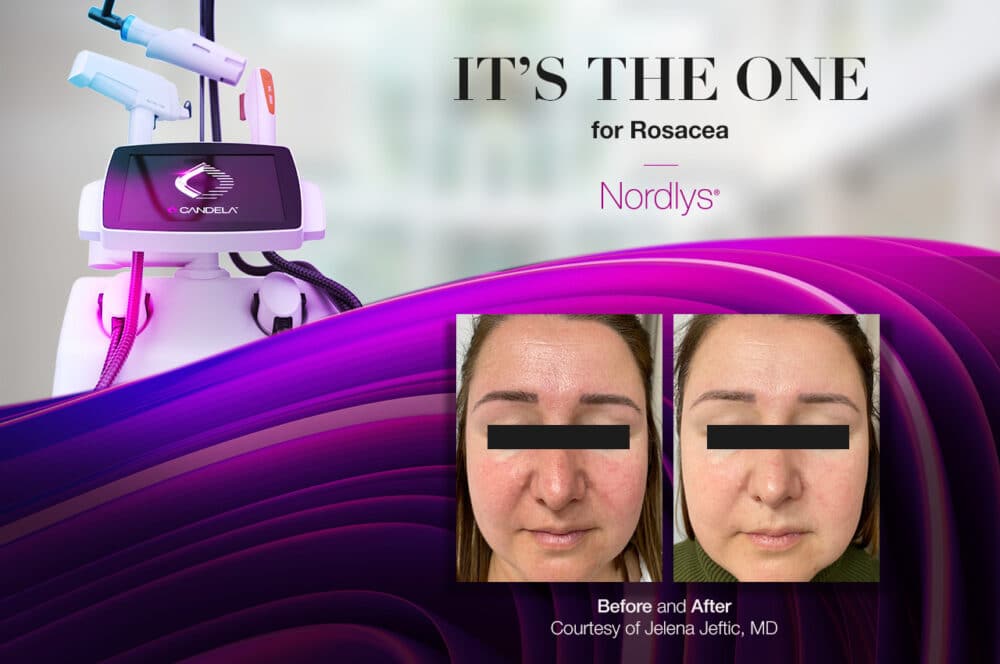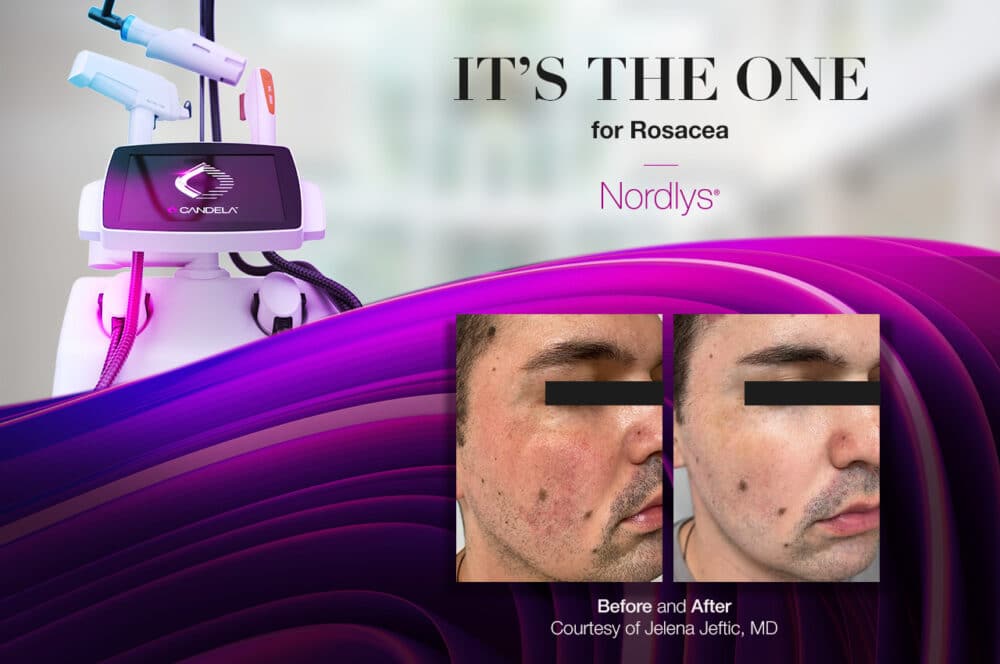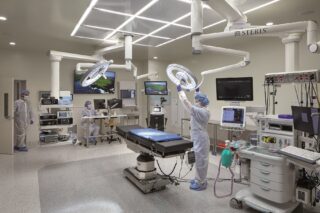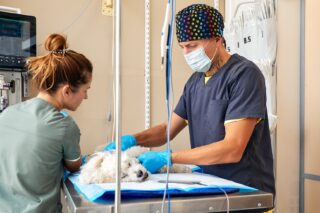Rosacea is a chronic, inflammatory facial dermatosis marked by episodes of facial flushing, erythema, and other symptoms. Although it primarily affects fair-skinned individuals, its incidence in darker skin tones is rising. This bulletin presents two case studies highlighting the efficacy of the Nordlys® multi-application platform using SWT® Narrowband IPL therapies for treating vascular cases of rosacea.
This article was written by Jelena Jeftic, MD, Dermatologist, at Beauty & Wellbeing Concept Clinic in Belgrade, Serbia.
Rosacea is classified into four subtypes: erythematotelangiectatic (ETR), papulopustular (PPR), phymatous, and ocular.(1) This classification serves as a guide, recognizing that patients may exhibit multiple subtypes. Additionally, a granulomatous variant presents as uniform, persistent papules on the face, ranging from natural skin tone to a dull red-brown. Some scholars also include rosacea conglobata and rosacea fulminans (pyoderma faciale) within the rosacea spectrum.(2)
The pathophysiology of rosacea likely involves multiple factors, including immune-mediated and neovascular responses leading to cutaneous inflammation. Environmental triggers and genetic predispositions also contribute, with up to 20% of patients reporting a family history of rosacea. Triggers include UV exposure, certain foods and beverages, emotional stress, strenuous exercise, medications, and supplements.(3)
The microbiome plays an important role in maintaining proper immune function. Various microorganisms, such as Demodex folliculorum, Bacillus oleronius, Staphylococcus epidermidis, and Cutibacterium acnes, have been studied as potential contributors to rosacea’s pathogenesis through abnormal activation of the innate immune system via Toll-like receptor 2. Current evidence suggests that Helicobacter pylori infection is unlikely to play a role in rosacea’s pathogenesis.(4)
When dermatologists devise a treatment plan for rosacea, it typically involves medication, a rosacea-friendly skincare regimen, and strategies to prevent flare-ups. Treatment ranges from local therapy to systemic treatment, depending on the severity. Light therapies, such as intense pulsed light (IPL), are particularly effective, especially for the erythematotelangiectatic type of rosacea, employing principles of selective photothermolysis.(1)
The Nordlys® multi-application platform by Candela stands out as a versatile system offering various Selective Waveband Technology (SWT®) IPL applicators, including PR 530, PRS 530, VL 555, and VLS 555. These applicators are tailored for treating vascular lesions, making Nordlys® a comprehensive choice for managing rosacea.
Case Study One
A 40-year-old female with Fitzpatrick Skin Type II presented with erythemotelangiectatic rosacea. She exhibited pronounced and persistent centrofacial erythema, primarily affecting the nose and cheeks, accompanied by skin sensitivity. Previous treatments with topical metronidazole gel 0.75% and anti-redness dermo-cosmeceuticals yielded no improvement.
Three sessions of Candela Nordlys treatments were administered at 4-week intervals to achieve optimal clinical outcomes. Initially, the PR 530 nm handpiece was used, starting with default settings for rosacea and facial telangiectasias, then transitioning to expert settings with sub-millisecond pulses. Cooling was applied between passes for patient comfort. During the final procedure, the Nd:1064 nm handpiece was used for resistant telangiectasias on the nose. Intense erythema and edema diminished within 24-48 hours post-treatment. Post-treatment care included regenerative cream for 5-7 days and mandatory sunscreen use.

Case Study Two
A 27-year-old male with Fitzpatrick Skin Type III presented with erythemotelangiectatic rosacea, primarily affecting the zygomatic area and lower cheeks. He reported flushing and burning sensations. Initial treatment used the Nordlys VL 555 handpiece, combining Rosacea and Facial Telangiectasias settings, alongside regular home care products and mandatory sunscreen. Cooling was applied between passes for patient comfort. Then treatment transitioned to the PR 530 handpiece with sub-millisecond pulse duration to minimize purpura. Post-procedure, the patient experienced slight edema lasting 24 hours, with no other side effects. Addressing telangiectasia was a priority in this treatment protocol.
CLICK here for the latest clinical bulletin.

Summary
Rosacea significantly impacts quality of life, self-esteem, and overall well-being. While it is a chronic condition with periods of remission and flare-ups, achieving complete clearance is possible. (5) Various treatment modalities, including SWT narrowband IPL therapy, are effective in managing rosacea symptoms. (6,7) The sequential application of different treatment modes tailored to the individual’s skin condition can yield optimal outcomes.
In our cases, Candela Nordlys SWT VL 555 and PR 530 delivered precise narrowband IPL with sub-millisecond pulse durations, targeting dilated blood vessels through selective photothermolysis without harming surrounding skin tissue. This approach ensures optimal results for treating rosacea (ETR), enhancing patient comfort, minimizing downtime, and facilitating the integration of multiple technologies within a single session. With experience, clinicians can adeptly employ diverse modalities to achieve expedited outcomes without adverse effects.
References
1. Daou H, Paradiso M, Hennessy K, Seminario-Vidal L. Rosacea and the Microbiome: A Systematic Review. Dermatol Ther (Heidelb). 2021 Feb;11(1):1-12. doi:10.1007/s13555-020-00460-1. Epub 2020 Nov 10.PMID: 33170492; PMCID: PMC7859152.
2. Jean L. Bolognia MD, Julie V. Schaffer MD, Lorenzo Cerroni MD, Dermatology eBook, Elsevier, 4th Edition, November 23, 2017, Page 604.
3. Bernstein EF, Kligman A. Rosacea treatment using the new-generation, high-energy, 595 nm, long pulse-duration pulsed-dye laser. Lasers Surg Med.2008 Apr;40(4):233-9. doi: 10.1002/lsm.20621. PMID: 18412227.
4. Zhu W, Hamblin MR, Wen X. Role of the skin microbiota and intestinal microbiome in rosacea. Front Microbiol. 2023 Feb 10;14:1108661. doi: 10.3389/fmicb.2023.1108661. PMID: 36846769; PMCID: PMC9950749.
5. Schaller M, Tan J, Webster G. How to Optimize Rosacea Treatment for Better Patient Outcomes: An Opinion Piece. J Clin Aesthet Dermatol. 2022 Jul;15(7):E60-E62. PMID: 35942011; PMCID: PMC9345196.
6. van Zuuren EJ, Arents BWM, van der Linden MMD, Vermeulen S, Fedorowicz Z, Tan J. Rosacea: New Concepts in Classification and Treatment. Am J Clin Dermatol. 2021 Jul;22(4):457-465. doi: 10.1007/s40257-021-00595-7. Epub 2021 Mar 23. PMID:33759078; PMCID: PMC8200341.
7. van Zuuren EJ, van der Linden MMD, Arents BWM. Rosacea treatment guideline for the Netherlands. Br J Dermatol. 2020 Jun;182(6):1504-1506. doi:10.1111/bjd.18882. Epub 2020 Feb
*Nordlys, CE Mark











